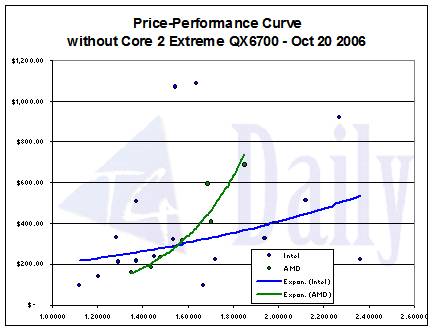Price/Performance Charts: Price of Core 2 Extreme drops ahead of quad-core launch
Extra performance is less expensive in Intel processors these days
The Intel curve has leveled off even more from last week to the point where it is almost a straight line compared to AMD. On average, this is a great development for consumers. It means that, if someone wants more processing power, they're going to have to pay very little for it and at least theoretically, you would get a linear increase in power for your extra dollars. Of course, that's on average, and the thing about averages is that sometimes extremes can alter the general image that's presented, which is certainly the case with Intel. The slopes are very telling: Intel's curve has a slope of 280, meaning that, on average, for every additional one-tenth increase on the relative performance index, it's going to cost you an extra $280. That number is $440 on AMD's side.
Performance without Core 2 Extreme QX6700: Click to enlarge and get more details
However, once again, let's look at the correlation coefficients of these graphs. For AMD, it's 0.942. This is just a little less than two weeks ago, when it was 0.965, most likely because of the imbalance of the price increases this week. Last week, the 4400+ threw off the correlation a bit, and brought it down to 0.903. Regardless, AMD remains extremely reliable in its pricing for the relatively short span of processor power it offers, compared to Intel.
Intel, however, has increased its price confusion even more with its price-performance correlation coefficient dropping to 0.301. Below 0.3 is generally considered the point where there's virtually no relationship between the two variables. However, while this may sound negative, it is actually creating a great deal of opportunities for consumers who spend some time watching the market. Determine your needs and these graphs can lead you to the best value in the processor market today. On the other hand, of course, it means that individuals not paying close attention to Intel processor pricing could end up with a very bad deal with a blue team CPU.
Performance with Core 2 Extreme QX6700: Click to enlarge and get more details
When the yet-to-be-released QX6700 is factored into our charts, however, the correlation actually doubles, to 0.600. This is because the high processor power, combined with the price (which carries a 269% price premium over the $446.03 relative price) the curve adapts to a more natural and exponential shape, which should be expected in a case such as this.
AMD's curve, which is truly exponential, is again undercut very quickly by Intel's curve, mainly because we do not have details on AMD's 4x4 platform package. For AMD to have the natural exponential curve over such a short distance on the x-axis, it needs to shoot up at a rapid pace, which it does. However, once AMD does come out with its new 4x4 high-end platform that is predicted to come out this year for about $800 - $900, we expect increased pricing pressure on AMD's mainstream processor family. At least at this time, it does not appear that 4x4 can solve AMD's problem of not having high volume mainstream processors in the $400 - $500 price range.
Get Tom's Hardware's best news and in-depth reviews, straight to your inbox.
However, the performance impact of the basic and non-overclocked 4x4 platform may not be as dramatic, as we hear that there may be very few applications that can take advantage of four cores at this time. We will have to wait for the first QX6700 vs. 4x4 shootout to get a better idea, where AMD stands these days.

Mark Raby is a freelance writer for Tom's Hardware, covering a wide range of topics, from video game reviews to detailed analyses of computer processors.

